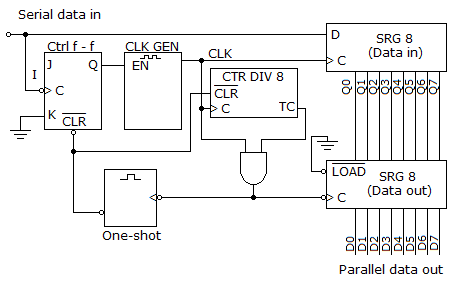Discussion
Home ‣ Digital Electronics ‣ Counters See What Others Are Saying!
- Question
What function does the CTR DIV 8 circuit given below perform?

Options- A. It divides the clock frequency down to match the frequency of the serial data in.
- B. The divide-by-8 counter is triggered by the control flip-flop and clock, which then allows the data output register to begin storing the input data. Once all eight data bits are stored in the data output register, the data output register and the divide-by-8 counter trigger the one-shot. The one-shot then begins the process all over again.
- C. The divide-by-8 counter is used to verify that the parity bit is attached to the input data string.
- D. It keeps track of the eight data bits, triggering the transfer of the data through the output register and the one-shot, which then resets the control flip-flop and divide-by-8 counter.
- Correct Answer
- It keeps track of the eight data bits, triggering the transfer of the data through the output register and the one-shot, which then resets the control flip-flop and divide-by-8 counter.
- 1. In the digital clock project, the ENT input and RCO output can be used for synchronous counter cascading.
Options- A. True
- B. False Discuss
- 2. A pull-up resistor is a resistor used to keep a given point in a circuit HIGH when in the active state.
Options- A. True
- B. False Discuss
- 3. The 74139 dual four-line demultiplexer functions as a demultiplexer if data input is on the
 line.
line.
Options- A. True
- B. False Discuss
- 4. When VGS = 0 on an N-channel MOSFET switch, there is no ________ between the source and the drain.
Options- A. voltage drop
- B. conductive channel
- C. capacitance
- D. inductance Discuss
- 5. The minimum number of flip-flops that can be used to construct a modulus-5 counter is ________.
Options- A. 3
- B. 5
- C. 8
- D. 10 Discuss
- 6. The timing network that sets the output frequency of a 555 astable circuit contains ________.
Options- A. three external resistors are used
- B. two external resistors and an external capacitor are used
- C. an external resistor and two external capacitors are used
- D. no external resistor or capacitor is required Discuss
- 7. When analog inputs from several sources are to be converted, a multiplexing technique can be used so that one ADC may be time-shared.
Options- A. True
- B. False Discuss
- 8. A parallel in/serial out shift register enters all data bits simultaneously and transfers them out one bit at a time.
Options- A. True
- B. False Discuss
- 9. In VHDL, if we need to remember a value it must be stored in a ________.
Options- A. function
- B. type declaration
- C. variable
- D. process Discuss
- 10. The summing outputs of a half- or full-adder are designated by which Greek symbol?
Options- A. omega
- B. theta
- C. lambda
- D. sigma Discuss
More questions
Correct Answer: True
Correct Answer: True
Correct Answer: True
Correct Answer: conductive channel
Correct Answer: 3
Correct Answer: two external resistors and an external capacitor are used
Correct Answer: True
Correct Answer: True
Correct Answer: function
Correct Answer: sigma
Comments
There are no comments.More in Digital Electronics:
Programming
Copyright ©CuriousTab. All rights reserved.
